Dolls and Angels – Video Blog Post
This week, I have a video blog post for you! I talk about dolls and angels – winter, the new class Doll World and Christmas memories, among other things!
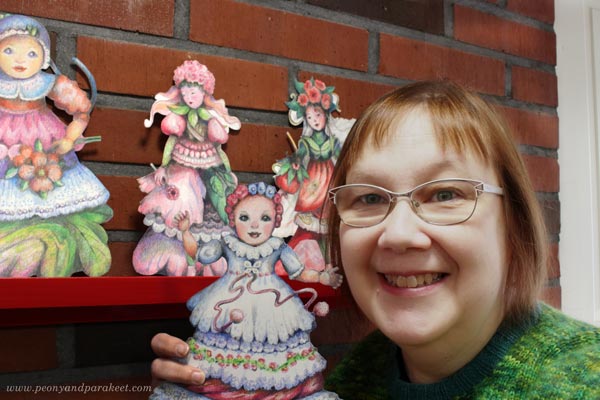
You will also see my table at the recent sales event. I hope you enjoy the video!
Dolls and Angels – Watch the Video!
Links to Related Blog Posts
- The previous video blog post
- Instructions for drawing a winter angel
- Preparing for the sales event
- The half-body figure: Creating a Protector of Good
- The painting: Winter Night’s Poem
- About painting a series: Inspired by Nature
Related Online Classes
- Doll World – Sign up here!
- Make a chapter for your colored pencil journal: Fun Botanicum
- The evolution from drawing to coloring and then to painting: 1) Inspirational Drawing, 2) Intuitive Coloring, 3) Floral Freedom
How Your Personal Story is Related to Your Art
This week, I share how my newest painting was born. At the same time, I talk about how the artist’s personal story affects the outcome.
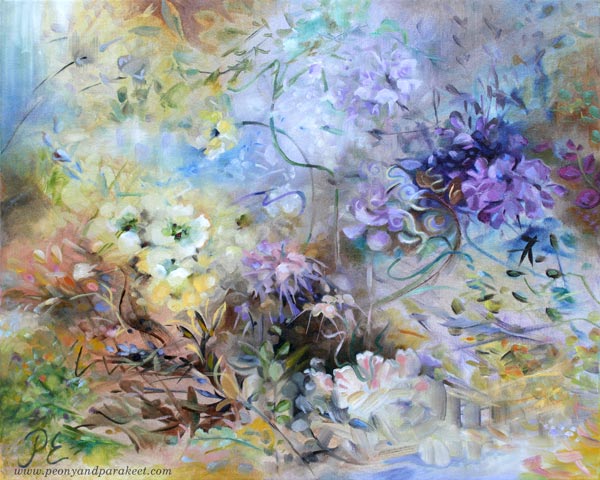
My paintings usually reflect the current season. But now, when there’s a fall in Finland, something springy appeared on my canvas. I call this one “The Spring of Dreams.”
Observing a Flower – Engineer’s and Romantic’s Approaches
Last spring was beautiful. The apple and cherry trees were blossoming.
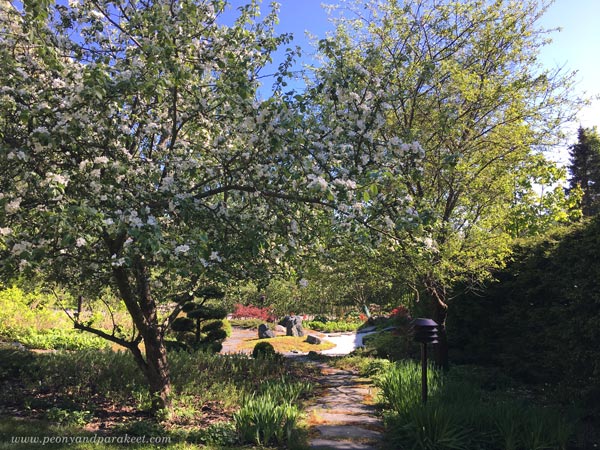
And with the early summer came wonderful irises.
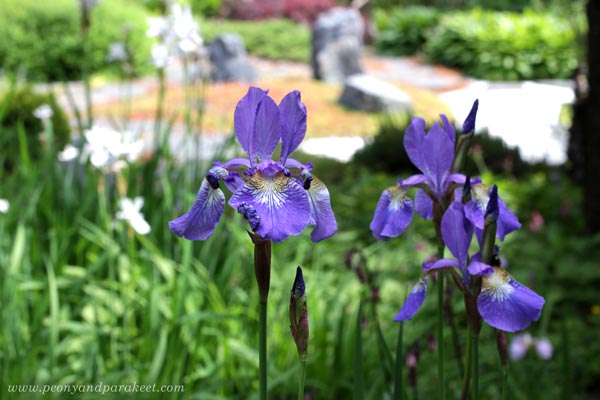
I often take photos in the garden and examine the plants. As a former engineer, I try to see how they are constructed. Not how the petals are attached and such, but how the light constructs the flower, adding its own brushmark to it. As a romantic, I try to see a face of a flower. I look at it like it would be an animal or a human – like it has a name and a history. I am not searching for its eyes but trying to sense its needs and dreams.
This way, I don’t need to copy photos but can paint freely and intuitively. Then when random shapes begin to look like a lighted plant, I try to give it what it wants, even if it’s often a species that doesn’t even exist.
The Fight Between Too Stiff and Too Messy
However, the painting process is not always as straightforward as it sounds. Often the engineer adds something stiff, and the romantic wipes it off. Then the romantic makes a mess, and the engineer tries to clean it.
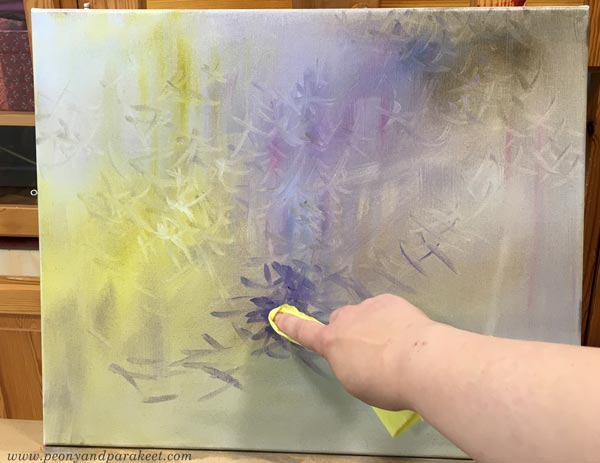
The engineer in me likes to build things with a brush: “There’s a chair, look!”
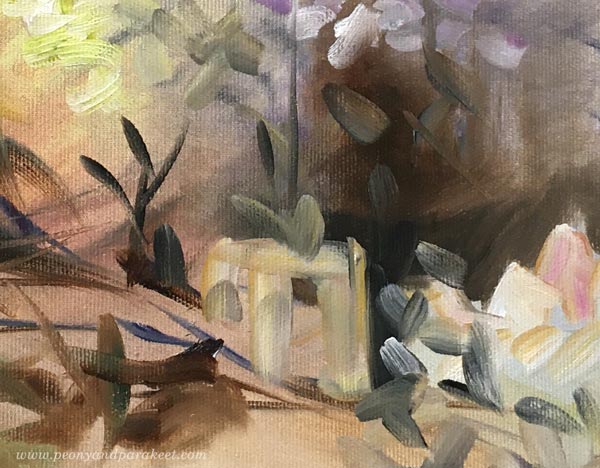
The romantic in me likes leaves and swirls more.
Artistic Direction and Setting Guidelines
To stop the fights, I gave an artistic direction that set challenges for both of them: “We will be making a dreamy floral that has purple. The painting should fit a modern, feminine home that has some rustic elements as well.” Both the engineer and the romantic understand had a common understanding of style when picturing a space where the painting should fit. When I use this method, I choose a location in my home or a picture in an interior design book, or a photo found on Instagram.

When I was studying industrial design, these kinds of simple and concrete guidelines were called design drivers. Design drivers are different from design principles. Design principles are general guidelines to make your image more expressive and aesthetic. Design drivers are project-based and loosely define the outcome.
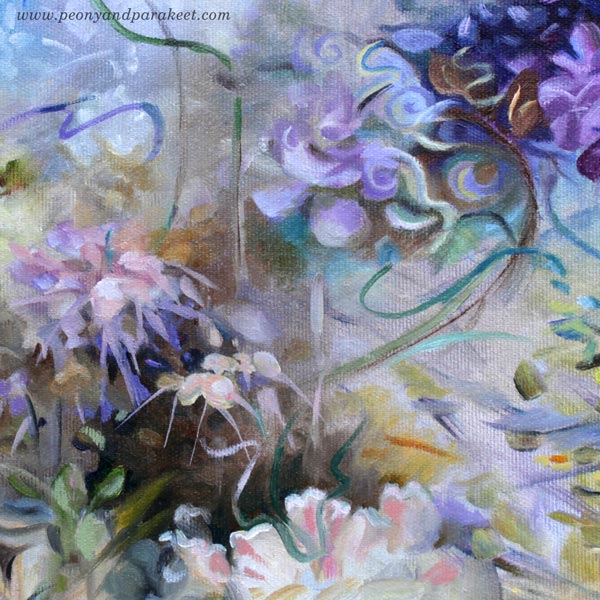
Design drivers prevent me from painting this and that, but I try to make them so general that I can get creative and freely express myself. For example, the requirement to use purple in a painting is not a big limitation.
Personal Story and Art Projects
Behind design drivers, there’s a more general foundation, an artistic vision. My paintings always lean toward the past and have a historical feel. As an artist, I want to combine the past and the present in an uplifting way, creating a fantasy of immortality for the interior space. Because I lost both of my parents at a young age, I never thought I would live old. This way, my artistic vision, and personal story are connected.

I claim that art-making has many layers. It’s not only about the process, techniques, or assignment. The artistic vision and the personal story matter as well. You always have a chance to bring them in, whether you are painting or drawing. For example, if a course sets the starting point, the creative challenge is how to include your artistic vision and story in the projects. This time, rather than listing things you love, go deeper and think about your struggles. How do they define what you want to achieve in art?
Turning Memories into Paintings
This week, I talk about memories and art-making and how the connection between them can be loose but still important.
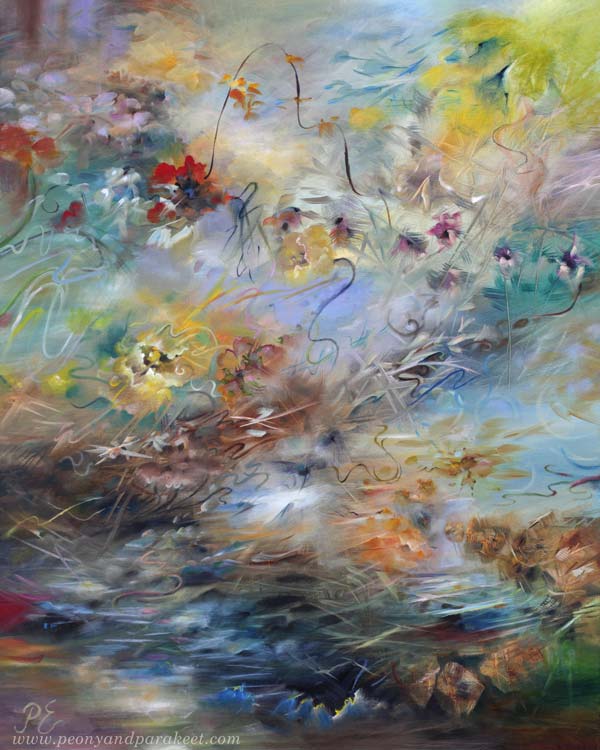
With this new painting, I want to talk about …
Books and Memories
My parents never visited another country, and as a child, I never traveled abroad. My first foreign trip was to England when I was 21 years old.
So when I think about my childhood, the first feeling that comes to mind is boredom. “Äiti, mitä mie tekisin – Mother, what could I do next?” I often asked. But my mother’s suggestions were never inspiring, and if my friends weren’t around, I usually chose to walk to the local library so that I could see the world.
My body was local, but my mind was international. Maybe it’s because our family had the book Tuhannen ja yhden yön satuja – One Thousand and One Nights, and I found it fascinatingly exotic at a very early age.
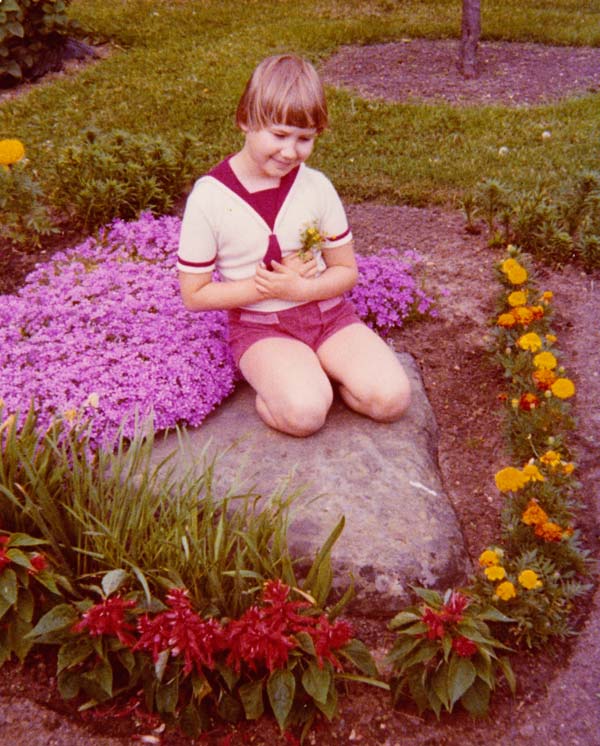
So the local library became my globe. As soon as I opened the door, I glanced at England, to the bookshelf where Jane Austen‘s novels were in a row. Then I went to Africa and Asia by browsing big encyclopedias of animals, searching for big cats. I traveled to Egypt when admiring the treasures of the pyramids. I spent hours in France and Italy, contemplating whether I liked impressionism or expressionism more. Pictures of folk dresses took me to the east, across the border. I traveled west over the sea to meet my friends Uudenkuun Emilia – Emily of the New Moon, Laura Ingalls, or Vihervaaran Anna – Anne of Green Gables. And I also spent quite a lot of time in a fictional American town through Spoonriver Anthology by Edgar Lee Masters.
When my fingers danced on the spines of the books, my mind contemplated where to go next. And always, I was able to find a place more pleasant than the small town in Eastern Finland.
Painting Freely, Inspired by Memories
This freedom of mind still inspires me. In fact, this blog is one channel to reach you who lives far away. Despite the distance, you may have read the same books, yet our memories are unique. The common stories and pictures get mixed with personal experiences and views.
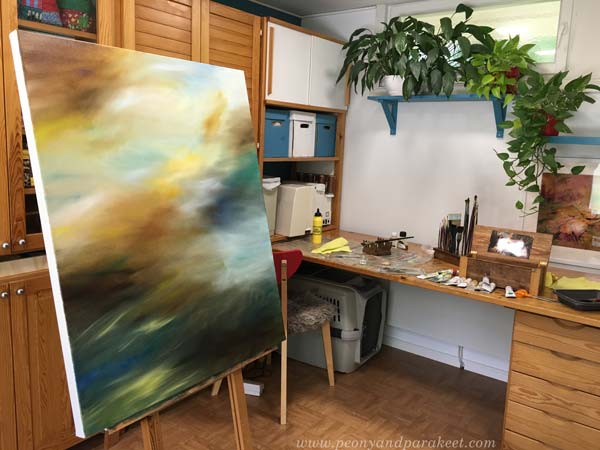
No matter how current we want to be, memories always play some role in our art too. When painting freely, it’s not as literal as illustrating a story but more about the atmosphere and associations that a traveling brush can evoke.
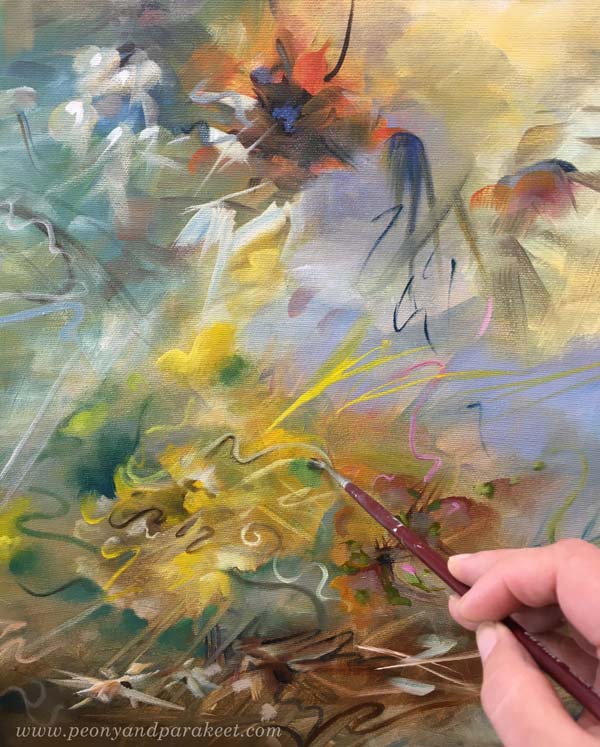
Like a child, we can get enthusiastic about very little – about a spot or a simple idea and then expand our thoughts, shapes, and colors.
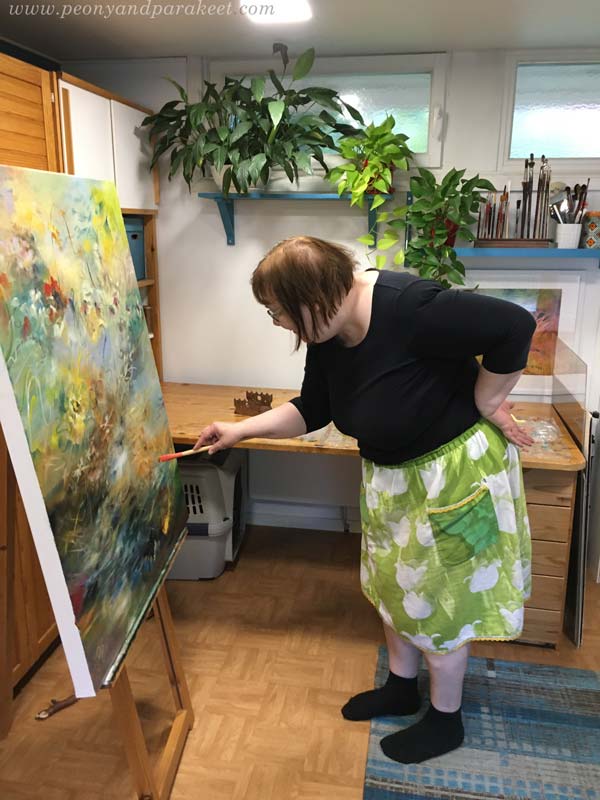
I believe that the more we paint, the more we remember who we naturally are.
My Artist’s Journey
My artist’s journey has been full of practice. A lot of it has been that I have developed a class of my recent revelations and then moved forward to find more. So, it’s been a very straightforward route that way, and I am oddly relieved that it has brought me where I am now, being able to use a brush as my pen and paint stories that go beyond words.
Right now, it doesn’t feel right to develop a new class about painting, especially when I already have the master class Floral Freedom.
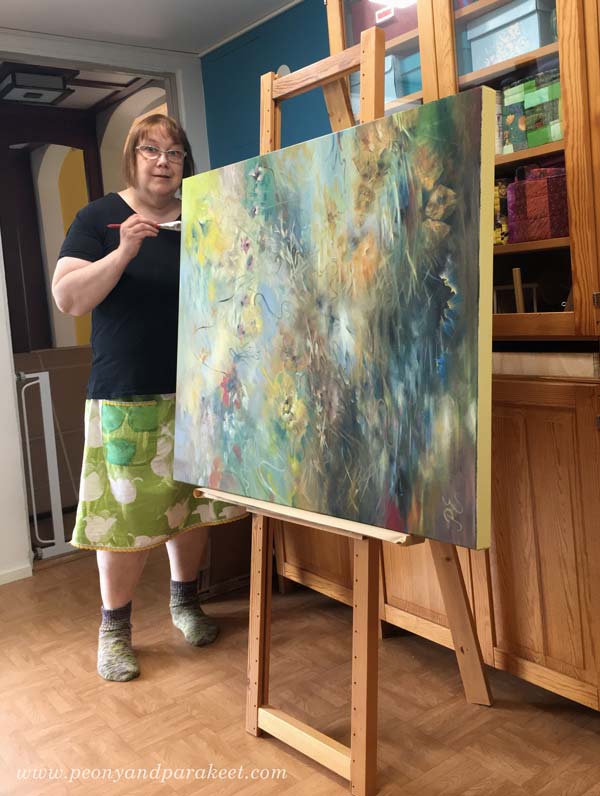
However, with the current series of paintings, I have got new ideas for drawing. A big part of my painting skills and imagination have come from drawing practices, and I love the quickness and playfulness that pens and pencils enable. So stay tuned!
Tiger’s Eye – Memories into Painting
I painted this piece, Tiikerinsilmä – Tiger’s Eye, like it would be a good book, taking me to unexpected places. Just like a child sees the world in a library, as an artist, I try to stretch my memories and imagination so that I don’t get stuck in the mundane.
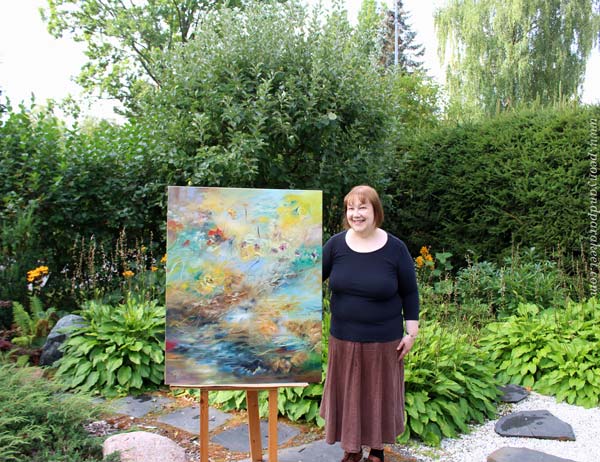
What kind of memories and hopes came to your mind when reading this post? Did you, too, read One Thousand and One Nights, for example?
Angel Drawing for the Inner Child
As a child, I had a collection of scrap reliefs – small pictures printed and cut from glossy paper. A very common one was a simple angel with a head between wings. This week, I created my version of an angel drawing.
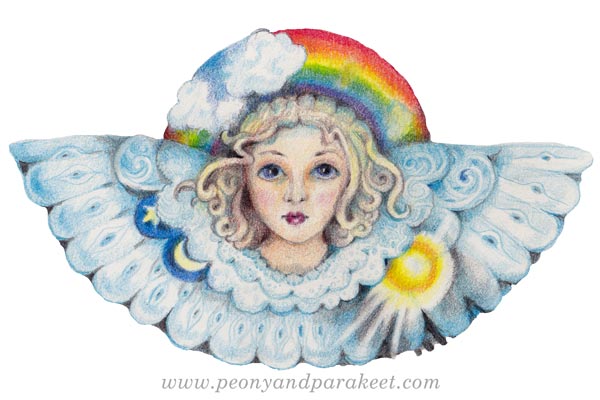
This is only a small piece on smooth watercolor paper, but the child in me likes it a lot!
My Approach to Drawing and Painting
My desire for art can be summed up in two parts. The first part is to go on an adventure by painting freely.
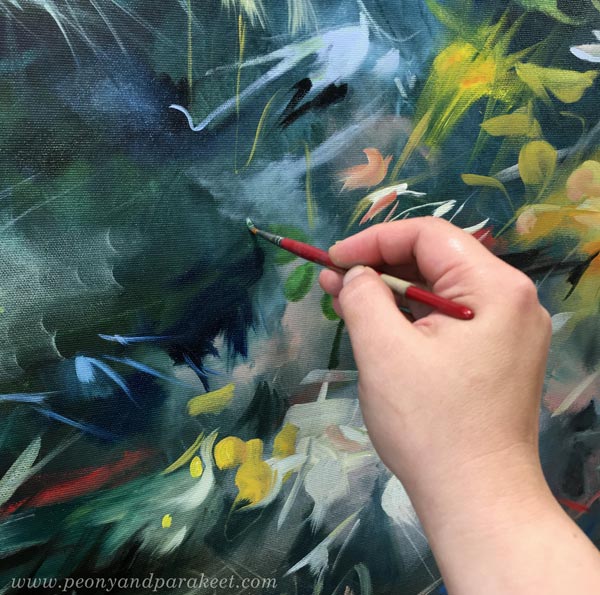
When I paint, I feel that it’s the only thing that I want to do and where I am good at.
But then, after washing the brushes, comes the second part. A child in me evokes and says: “Draw to me!” Like I often said to my father or to my sisters when I was only a few years old. The child doesn’t require much: “Something pretty!” (Watch a video about my inner child!)
Child’s Enthusiasm in Angel Drawing
I used to adore whatever my father or sisters drew. Now, similarly, I feel the acceptance of the child right from the beginning. No matter how I struggle with any detail, the child’s enthusiasm keeps me drawing.
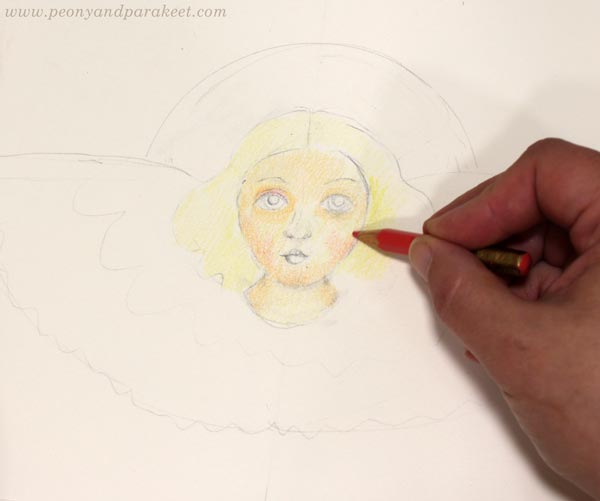
And even if I had just thought that I should only paint and do nothing else, drawing a small ornament feels as natural and enjoyable. The same creative stream seems to feed both parts of my artistic expression.
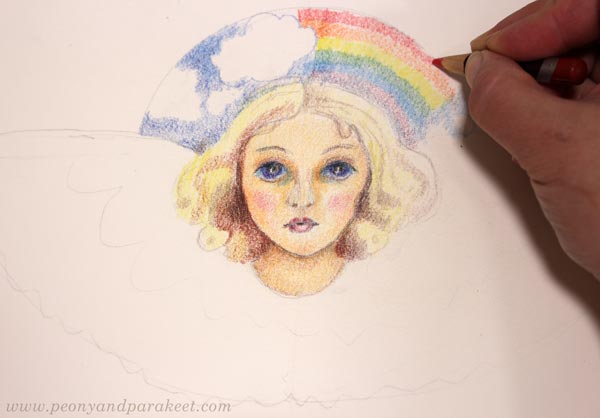
A simple sketch gets more ideas when I start adding details. Coloring a halo with yellow feels boring, so I draw clouds, then a rainbow. An unwritten story begins to flow into the image.
Small Tweaks to a Simple Sketch Make the Angel Drawing
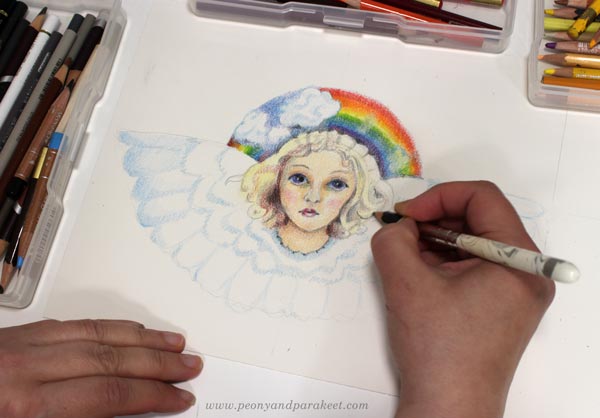
Simple shapes become more interesting when I keep drawing. Quick and simple wings get more decoration, and small adjustments to the face and hair add up.
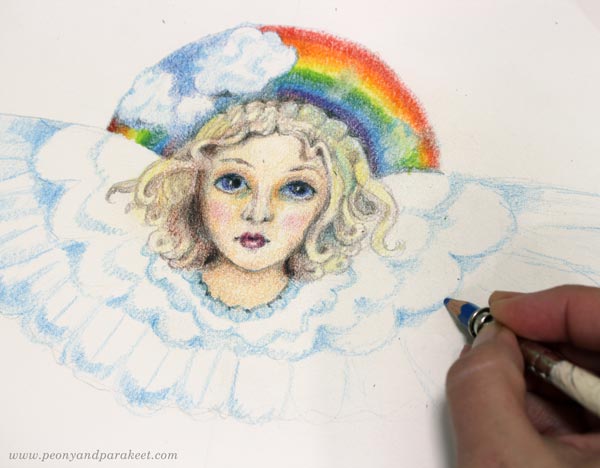
At best, I get the feeling that, like in painting, I can go in any direction and create a world of my own.

This little weather angel became a treasure to my inner child even before it was finished.
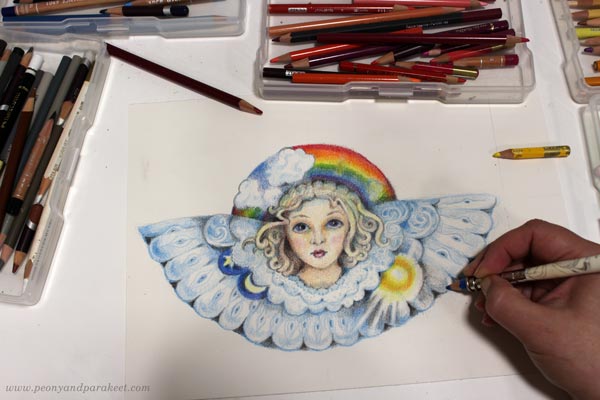
And when I handed the angel to her, she was thrilled to have her in the collection.
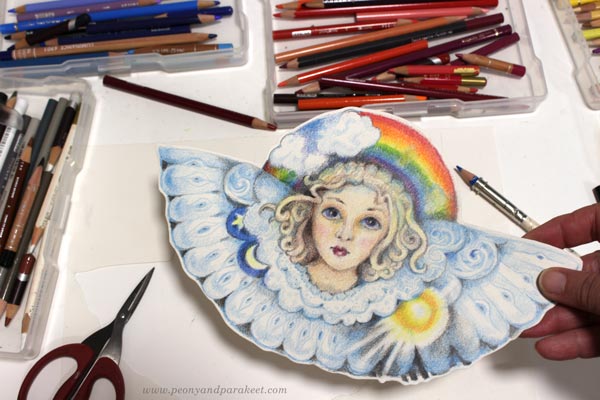
It feels that if I don’t cut the picture, it’s not ready for play!
Going Detailed with Colored Pencils
It has taken time to find colored pencil techniques to achieve similarly detailed touch like in Animal Inkdom and Magical Inkdom.
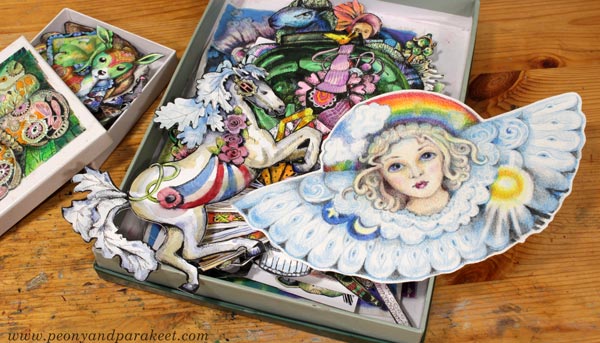
Making small pieces with colored pencils is more challenging than with ink pens, but maybe it doesn’t matter. I remember having a huge paper doll as a child. So, I could go larger without disappointing the inner child!

What would you like to create for your inner child?